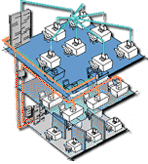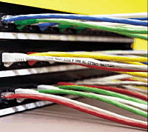|
|
|
In
the past, buildings could have several different cabling
systems for different communications systems, for
example; block wiring for voice, thin ethernet, RS232
and Token Ring etc.
|
| |
|
The
ideal solution is to install a standard cable
and connector type throughout a building which
could, with additional equipment, be used to
support all or most of the different type of
systems in use. This is known as Generic
Cabling. |
| |
|
Also,
for true flexibility, it would be desirable to
have this generic cabling installed and ready
for use at all possible locations within a site.
This would allow a department to expand or to
move to another area with minimum disruption,
more importantly saving costs! This is commonly
known as Flood Wiring. |
|
| |
|
A
structured cabling system consists of outlets,
which provide the user with an RJ45
presentation. Each user outlet is cabled back to
a rack cabinet using an individual cable
containing four twisted pairs, this cabling is
known as the 'horizontal cabling'. In most
cases, cable which meets the Category 5e
specification is used for the horizontal
cabling. This cable is terminated onto a patch
panel and presented as an RJ45 outlet with
different size panels from 16 to 48 way thus
providing a connection to the required service. |
|
|
In
a true structured cabling systems, the horizontal
cabling and user outlets are the same for all services,
so that any outlet can be configured for voice,
Ethernet, RS232, video or other service. As user
requirements change, the service provided on the outlets
can be changed simply by changing the patching
configuration in the rack cabinets. If necessary, an
adapter is used in the outlet to convert it to the
service being provided for example, a video balun will
provide the standard RGB, composite video outputs
required for CCTV or BT style plug for a telephone
systems. |
| |
|
Flexible
and reliable cabling is essential to a productive
network. Fully structured UTP Cat5e & 6 cable is
provided form the best manufacturers in the industry and
installed by trained qualified engineers to the highest
standards. |
| |
|
Category
5e, like Category 5 is a 100MHz classification. However,
the performance requirements of a Category 5 Enhanced
system are more stringent. Category 5e reliably supports
100BaseTX and ATM 155 protocols over copper cabling.
Gigabit Ethernet and ATM 622 can also be supported but
take the cable to it's limits by utilizing all 4 pairs
equally split with 250Mbps being transmitted. |
| |
|
Category
6 or class E is a 200MHz classification and has not been
ratified to date. An installation in category 6 cable
must use the same manufactures patch/fly leads and
outlets to reach the above performance and pass the
current tests.
|
|
|



